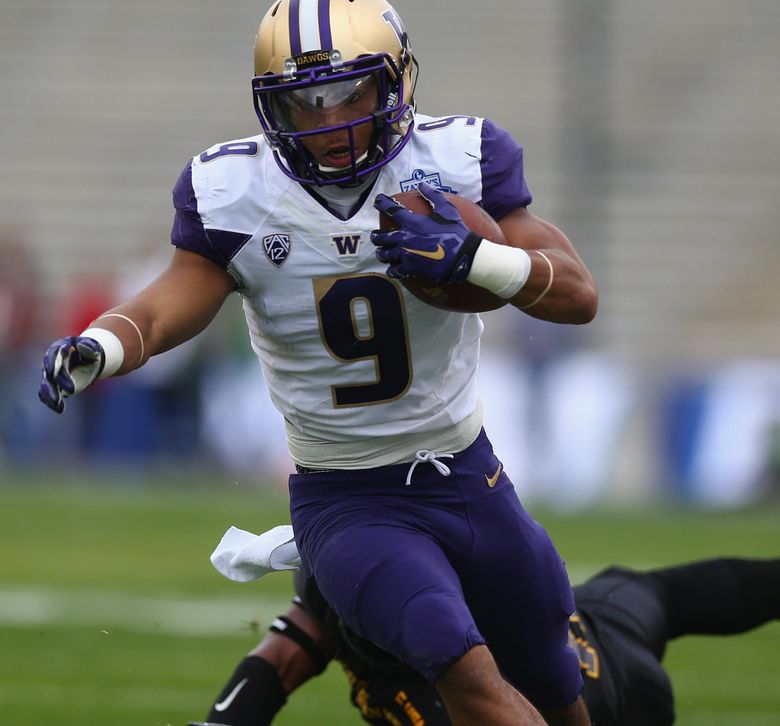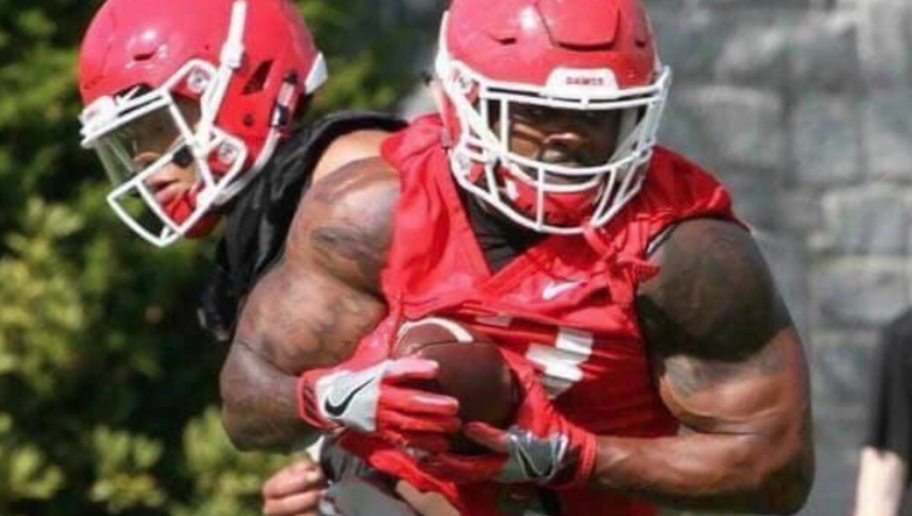- Thread starter
- #1
AlaskaGuy
Throbbing Member
https://athlonsports.com/college-football/college-footballs-top-50-running-back-units-2018
1. Alabama
A statement that will surprise no one: Alabama (again) has the deepest backfield in college football. Damien Harris passed on the NFL for one more year in Tuscaloosa, and the senior is set to lead the backfield after rushing for 1,000 yards and 11 scores last season. Najee Harris impressed in limited action (370 yards on 61 carries) and is set for a larger role on offense after Bo Scarbrough left for the NFL. Brian Robinson and Josh Jacobs are both capable of being the top ball carrier at almost every other program.
2. Wisconsin
Jonathan Taylor delivered one of the best statistical seasons by a freshman running back in FBS history last season. The New Jersey native set a new freshman record by rushing for 1,977 yards and reached the end zone 13 times. With Wisconsin’s run-first approach and the nation’s No. 1 offensive line clearing the way, Taylor’s sophomore campaign could be even better than his prolific debut. Bradrick Shaw (recovering from an ACL injury) returns after rushing for 365 yards last year, with Chris James and Taiwan Deal also in the mix as key reserves.
3. Stanford
After 2,118 rushing yards and a runner-up finish in Heisman Trophy voting, Bryce Love seemed destined to head to the NFL. Instead, Love decided to return to The Farm for his senior campaign. Big plays fueled Love’s run at the Heisman, as he averaged 8.1 yards per carry and set a new FBS record with 13 rushes of 50 or more yards. Love rushed for at least 100 yards in 12 out of the 13 games he played. Cameron Scarlett (389 yards in 2017) and Trevor Speights (142) have performed well in limited work.
4. Ohio State
Ohio State’s rushing attack led the Big Ten with an average of 243.2 yards per game and could be an even bigger part of the offense after the departure of quarterback J.T. Barrett. J.K. Dobbins was one of college football’s top freshmen in 2017, rushing for 1,403 yards and finishing first in the Big Ten by averaging 7.2 yards per carry. Mike Weber led the team with 1,096 yards in 2016 but was slowed by a hamstring injury last year. Despite the injury, Weber still managed 626 yards and 10 touchdowns. True freshman Master Teague will be in the mix for carries as well.
5. Florida State
The ACC’s top running back is Boston College’s AJ Dillon, but the deepest corps in the conference resides in Tallahassee. Cam Akers led the team with 1,025 yards and tied Jacques Patrick for the most touchdowns (seven). Akers will be involved even more as a sophomore in new coach Willie Taggart’s Gulf Coast Offense. Patrick is back as the No. 2 option, with Amir Rasul and Khalan Laborn rounding out a talented group.
6. Oklahoma
Despite losing two 1,000-yard rushers from 2016, Oklahoma’s ground attack never missed a beat last season. Rodney Anderson delivered a breakout season by rushing for 1,161 yards and 13 touchdowns. He capped the year by gashing Georgia for 201 yards in the Rose Bowl. Trey Sermon also impressed with 744 yards in his true freshman season and is back to work as the No. 2 option. Depth is plentiful with redshirt freshman Kenny Brooks, senior Marcelias Sutton and four-star recruit T.J. Pledger in the mix.
7. Georgia
The Bulldogs must replace 1,000-yard rushers Nick Chubb and Sony Michel, but as usual the ground game isn’t going to miss a beat in Athens. D’Andre Swift flashed potential in a limited role last year, rushing for 618 yards and three touchdowns on just 81 carries. He’s set to take over the No. 1 role but will have support from juniors Elijah Holyfield (293 yards in 2017) and Brian Herrien (265). Additionally, Georgia’s No. 1 recruiting class will deliver two more impact backs. Zamir White was regarded as the top running back prospect in the 2018 class, while James Cook — the brother of former Florida State star Dalvin Cook — was a four-star recruit.
8. Washington
Myles Gaskin has eclipsed 1,000 yards in each of his three seasons in Seattle and enters 2018 as the FBS active leader in yardage (4,055). The Washington native has scored 45 times on the ground and boasts a career average of 5.9 yards a carry. He also has 44 catches for 388 yards and four touchdowns over the last three years. Lavon Coleman expired his eligibility, but Salvon Ahmed is primed for a breakout year. He rushed for 388 yards and three scores as a freshman last fall and can be used as an all-purpose threat for play-caller Bush Hamdan. Sean McGrew and Kamari Pleasant round out the key contributors at this position for coach Chris Petersen.
9. Boston College
AJ Dillon quickly earned a place among college football’s top running backs last season. In his true freshman campaign, Dillon set a new school record for most rushing yards by a true freshman and earned ACC Rookie of the Year honors. The Connecticut native recorded 1,589 yards and 14 touchdowns and averaged 5.3 yards a carry over 13 contests. With Jon Hilliman transferring to Rutgers, Travis Levy is likely to assume the No. 2 role in the backfield.
10. Clemson
Wayne Gallman’s early departure to the NFL pushed Travis Etienne and Tavien Feaster into the go-to role at running back last season. This duo didn’t disappoint, combining for 1,435 yards and 20 touchdowns on just 214 carries. Etienne had a penchant for producing big plays, averaging 7.2 yards a carry and recording four rushes of 50 yards or more. Senior Adam Choice and freshman Lyn-J Dixon are next in line for carries.
11. FAU
12. Oklahoma State
13. Miami
14. Iowa State
15. Michigan
16. Mississippi State
17. Utah
18. USC
19. Florida
20. Georgia Tech
21. Penn State
22. Missouri
23. Memphis
24. Oregon
25. Kentucky
26. Auburn
27. Appalachian State
28. Notre Dame
29. Michigan State
30. Maryland
31. Arkansas
32. Army
33. TCU
34. Ball State
35. Nebraska
36. South Carolina
37. North Carolina
38. UNLV
39. San Diego State
40. UCF
41. Toledo
42. Western Michigan
43. Texas A&M
44. Tennessee
45. UAB
46. Kansas State
47. SMU
48. Tulane
49. Ohio
50. West Virginia
Just Missed: Pitt, Tulsa, Texas, Purdue, Minnesota, Northwestern, Colorado State, Boise State, Louisiana, Old Dominion, Marshall, Miami (Ohio), UMass, Nevada, Fresno State, Arizona, Arkansas State, Troy
1. Alabama
A statement that will surprise no one: Alabama (again) has the deepest backfield in college football. Damien Harris passed on the NFL for one more year in Tuscaloosa, and the senior is set to lead the backfield after rushing for 1,000 yards and 11 scores last season. Najee Harris impressed in limited action (370 yards on 61 carries) and is set for a larger role on offense after Bo Scarbrough left for the NFL. Brian Robinson and Josh Jacobs are both capable of being the top ball carrier at almost every other program.
2. Wisconsin
Jonathan Taylor delivered one of the best statistical seasons by a freshman running back in FBS history last season. The New Jersey native set a new freshman record by rushing for 1,977 yards and reached the end zone 13 times. With Wisconsin’s run-first approach and the nation’s No. 1 offensive line clearing the way, Taylor’s sophomore campaign could be even better than his prolific debut. Bradrick Shaw (recovering from an ACL injury) returns after rushing for 365 yards last year, with Chris James and Taiwan Deal also in the mix as key reserves.
3. Stanford
After 2,118 rushing yards and a runner-up finish in Heisman Trophy voting, Bryce Love seemed destined to head to the NFL. Instead, Love decided to return to The Farm for his senior campaign. Big plays fueled Love’s run at the Heisman, as he averaged 8.1 yards per carry and set a new FBS record with 13 rushes of 50 or more yards. Love rushed for at least 100 yards in 12 out of the 13 games he played. Cameron Scarlett (389 yards in 2017) and Trevor Speights (142) have performed well in limited work.
4. Ohio State
Ohio State’s rushing attack led the Big Ten with an average of 243.2 yards per game and could be an even bigger part of the offense after the departure of quarterback J.T. Barrett. J.K. Dobbins was one of college football’s top freshmen in 2017, rushing for 1,403 yards and finishing first in the Big Ten by averaging 7.2 yards per carry. Mike Weber led the team with 1,096 yards in 2016 but was slowed by a hamstring injury last year. Despite the injury, Weber still managed 626 yards and 10 touchdowns. True freshman Master Teague will be in the mix for carries as well.
5. Florida State
The ACC’s top running back is Boston College’s AJ Dillon, but the deepest corps in the conference resides in Tallahassee. Cam Akers led the team with 1,025 yards and tied Jacques Patrick for the most touchdowns (seven). Akers will be involved even more as a sophomore in new coach Willie Taggart’s Gulf Coast Offense. Patrick is back as the No. 2 option, with Amir Rasul and Khalan Laborn rounding out a talented group.
6. Oklahoma
Despite losing two 1,000-yard rushers from 2016, Oklahoma’s ground attack never missed a beat last season. Rodney Anderson delivered a breakout season by rushing for 1,161 yards and 13 touchdowns. He capped the year by gashing Georgia for 201 yards in the Rose Bowl. Trey Sermon also impressed with 744 yards in his true freshman season and is back to work as the No. 2 option. Depth is plentiful with redshirt freshman Kenny Brooks, senior Marcelias Sutton and four-star recruit T.J. Pledger in the mix.
7. Georgia
The Bulldogs must replace 1,000-yard rushers Nick Chubb and Sony Michel, but as usual the ground game isn’t going to miss a beat in Athens. D’Andre Swift flashed potential in a limited role last year, rushing for 618 yards and three touchdowns on just 81 carries. He’s set to take over the No. 1 role but will have support from juniors Elijah Holyfield (293 yards in 2017) and Brian Herrien (265). Additionally, Georgia’s No. 1 recruiting class will deliver two more impact backs. Zamir White was regarded as the top running back prospect in the 2018 class, while James Cook — the brother of former Florida State star Dalvin Cook — was a four-star recruit.
8. Washington
Myles Gaskin has eclipsed 1,000 yards in each of his three seasons in Seattle and enters 2018 as the FBS active leader in yardage (4,055). The Washington native has scored 45 times on the ground and boasts a career average of 5.9 yards a carry. He also has 44 catches for 388 yards and four touchdowns over the last three years. Lavon Coleman expired his eligibility, but Salvon Ahmed is primed for a breakout year. He rushed for 388 yards and three scores as a freshman last fall and can be used as an all-purpose threat for play-caller Bush Hamdan. Sean McGrew and Kamari Pleasant round out the key contributors at this position for coach Chris Petersen.
9. Boston College
AJ Dillon quickly earned a place among college football’s top running backs last season. In his true freshman campaign, Dillon set a new school record for most rushing yards by a true freshman and earned ACC Rookie of the Year honors. The Connecticut native recorded 1,589 yards and 14 touchdowns and averaged 5.3 yards a carry over 13 contests. With Jon Hilliman transferring to Rutgers, Travis Levy is likely to assume the No. 2 role in the backfield.
10. Clemson
Wayne Gallman’s early departure to the NFL pushed Travis Etienne and Tavien Feaster into the go-to role at running back last season. This duo didn’t disappoint, combining for 1,435 yards and 20 touchdowns on just 214 carries. Etienne had a penchant for producing big plays, averaging 7.2 yards a carry and recording four rushes of 50 yards or more. Senior Adam Choice and freshman Lyn-J Dixon are next in line for carries.
11. FAU
12. Oklahoma State
13. Miami
14. Iowa State
15. Michigan
16. Mississippi State
17. Utah
18. USC
19. Florida
20. Georgia Tech
21. Penn State
22. Missouri
23. Memphis
24. Oregon
25. Kentucky
26. Auburn
27. Appalachian State
28. Notre Dame
29. Michigan State
30. Maryland
31. Arkansas
32. Army
33. TCU
34. Ball State
35. Nebraska
36. South Carolina
37. North Carolina
38. UNLV
39. San Diego State
40. UCF
41. Toledo
42. Western Michigan
43. Texas A&M
44. Tennessee
45. UAB
46. Kansas State
47. SMU
48. Tulane
49. Ohio
50. West Virginia
Just Missed: Pitt, Tulsa, Texas, Purdue, Minnesota, Northwestern, Colorado State, Boise State, Louisiana, Old Dominion, Marshall, Miami (Ohio), UMass, Nevada, Fresno State, Arizona, Arkansas State, Troy





























